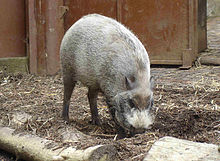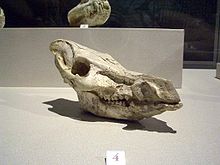en
names in breadcrumbs


Perception Channels: tactile ; chemical
Other Physical Features: endothermic ; bilateral symmetry
Key Reproductive Features: gonochoric/gonochoristic/dioecious (sexes separate); sexual
Diversity of Living Pigs
The family Suidae (pigs) is one of a number of families in the mammal order Artiodactyla (even-toed ungulates). Meijaard et al. (2011) recognized 12 species in the Suidae, although they note that clarifying the status of some of these will require further work, especially in the Philippines. One or more species are found throughout most of the Old World except for Australia, northern Africa, and far northern Eurasia (feral pigs are found even more widely, including in North America and on many Pacific islands). Various species can be found from near-desert conditions to closed forest in tropical, subtropical, and boreal regions. The most unusual-looking pigs are no doubt the babirusas, which have long, spindly legs, a nearly naked body, and, most strikingly, upper canines which (in males) grow up through the snout and continue to grow in a backward-curving spiral. The function of these remarkable, greatly enlarged canines remains unclear. The babirusas share a number of other unusual characteristics as well that have raised questions about whether they actually fall within the Suidae, but this question has not yet been resolved.
A distinctive feature of pigs is the unusual snout, with terminal nostrils which can be closed; the snout can be moved by the pig without moving its head. Most pig species are highly omnivorous, feeding even on carrion, but plant material typically accounts for a large proportion of the diet. With the exception of the Forest Hog and babirusas, pigs use their canines and flexible snout disk to root through soil looking for food and dig up roots and bulbs. Babirusas specialize on fruit and Forest Hogs feed more on grasses than any other pig species; Forest Hog piglets are fond of fresh elephant dung.
With the exception of the babirusas, which appear to have retained the foregut fermentation characteristic of ruminants, most pigs use hindgut fermentation in the caecum to digest cellulose, but their cellulose digestion is inefficient and pigs consequently must spend much of their time feeding.
All pigs use mud wallows when they have an opportunity to do so. Wallowing serves to cool the animal them and to protect it from ectoparasites (external parasites) and biting flies. Pigs nearly always rub themselves against a tree after wallowing.
Pigs are generally considered to be among the most intelligent mammals, after humans and other great apes, dolphins, and elephants. Their intelligence has been likened to that of a three-year-old child.
Pigs have a remarkable variety of scent glands, used in scent-marking, which aredistributed over various parts of their bodies.
Pigs are the only ungulates (hoofed mammals) to commonly produce large litters of offspring (up to half a dozen or even more than a dozen offspring at once).
Pigs and Humans
There are an estimated two billion domestic pigs on Earth (domestic pigs are derived mainly from the Eurasian Wild Pig and the Sulawesi Warty Pig). Pork accounts for a large proportion of global meat production (41% in 2007). In addition to eating pigs and, in some places, keeping them as pets, humans have used them to detect and dig for underground truffles. Available evidence suggests that pigs may have been domesticated independently in Europe, Asia Minor, the Far East (including Japan), and various parts of Southeast Asia. In many traditional human societies around the world, pigs have tremendous cultural importance. Feral pigs wreak environmental havoc in many regions where they occur. On the other hand, populations of most of the world's pig species are declining, some critically. Particularly vulnerable are those species ocurring in small and isolated populations in archipelagoes such as the Philippines, Indonesia, and Japan.
(Meijaard et al. 2011 and references therein)
Suidae is a family of artiodactyl mammals which are commonly called pigs, hogs or swine. In addition to numerous fossil species, 18 extant species are currently recognized (or 19 counting domestic pigs and wild boars separately), classified into between four and eight genera. Within this family, the genus Sus includes the domestic pig, Sus scrofa domesticus or Sus domesticus, and many species of wild pig from Europe to the Pacific. Other genera include babirusas and warthogs. All suids, or swine, are native to the Old World, ranging from Asia to Europe and Africa.
The earliest fossil suids date from the Oligocene epoch in Asia, and their descendants reached Europe during the Miocene.[1] Several fossil species are known and show adaptations to a wide range of different diets, from strict herbivory to possible carrion-eating (in Tetraconodontinae).[2]
Suids belong to the order Artiodactyla, and are generally regarded as the living members of that order most similar to the ancestral form. Unlike most other members of the order, they have four toes on each foot, although they walk only on the middle two digits, with the others staying clear of the ground. They also have a simple stomach, rather than the more complex, ruminant, stomach found in most other artiodactyl families.[3]
They are small to medium animals, varying in size from 58 to 66 cm (23 to 26 in) in length, and 6 to 9 kg (13 to 20 lb) in weight in the case of the pygmy hog, to 130–210 cm (4.3–6.9 ft) and 100–275 kg (220–606 lb) in the giant forest hog.[4] They have large heads and short necks, with relatively small eyes and prominent ears. Their heads have a distinctive snout, ending in a disc-shaped nose. Suids typically have a bristly coat, and a short tail ending in a tassle. The males possess a corkscrew-shaped penis, which fits into a similarly shaped groove in the female's cervix.[5][6][7]
Suids have a well-developed sense of hearing, and are vocal animals, communicating with a series of grunts, squeals, and similar sounds. They also have an acute sense of smell. Many species are omnivorous, eating grass, leaves, roots, insects, worms, and even frogs or mice. Other species are more selective and purely herbivorous.[3]
Their teeth reflect their diet, and suids retain the upper incisors, which are lost in most other artiodactyls. The canine teeth are enlarged to form prominent tusks, used for rooting in moist earth or undergrowth, and in fighting. They have only a short diastema. The number of teeth varies between species, but the general dental formula is: 1–3.1.2–4.3030.1.020.3.
Suids are intelligent and adaptable animals. Adult females (sows) and their young travel in a group (sounder; see List of animal names), while adult males (boars) are either solitary, or travel in small bachelor groups. Males generally are not territorial, and come into conflict only during the mating season.
Litter size varies between one and twelve, depending on the species. The mother prepares a grass nest or similar den, which the young leave after about ten days. Suids are weaned at around three months, and become sexually mature at 18 months. In practice, however, male suids are unlikely to gain access to sows in the wild until they have reached their full physical size, at around four years of age. In all species, the male is significantly larger than the female, and possesses more prominent tusks.[3]


The following 18 extant species of suid are currently recognised:[8]
Cladogram of Suidae. Mikko's Phylogeny Archive (Based is McKenna & Bell, 1997, Liu, 2003 и Harris & Liu, 2007):[9]
? ![]() Kenyasus
Kenyasus
? Euhys
Potamochoerini? ![]() Sinohyus
Sinohyus
Suidae is a family of artiodactyl mammals which are commonly called pigs, hogs or swine. In addition to numerous fossil species, 18 extant species are currently recognized (or 19 counting domestic pigs and wild boars separately), classified into between four and eight genera. Within this family, the genus Sus includes the domestic pig, Sus scrofa domesticus or Sus domesticus, and many species of wild pig from Europe to the Pacific. Other genera include babirusas and warthogs. All suids, or swine, are native to the Old World, ranging from Asia to Europe and Africa.
The earliest fossil suids date from the Oligocene epoch in Asia, and their descendants reached Europe during the Miocene. Several fossil species are known and show adaptations to a wide range of different diets, from strict herbivory to possible carrion-eating (in Tetraconodontinae).